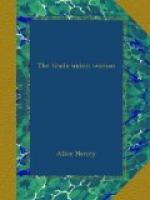For the origin of the Women’s Trade Union League, we must go back to 1874, when Mrs. Emma Patterson, the wife of an English trade unionist and herself deeply impressed with the deplorable condition of women wage-earners everywhere, was on a visit to the United States. The importance of combination as a remedy was freshly brought home to her through what she saw of the women’s organizations then most prominent and flourishing in New York, the Parasol and Umbrella Makers’ Union, the Women’s Typographical Union, and the Women’s Protective Union. She returned to England with a plan for helping women workers to help themselves. Shortly afterwards she and others whom she interested formed the Women’s Protective and Provident League, the title later on being changed to the bolder and more radical British Women’s Trade Union League, a federation of women’s unions, with an individual membership as well. It is known to the public on this side of the water through the visits of Mary Macarthur, its very able secretary.
This body had been in existence nearly thirty years before the corresponding organization was formed in this country. About 1902 Mr. William English Walling had his attention drawn to what the British Women’s Trade Union League was accomplishing among some of the poorest working-women in England.
He mentioned what he had learned to others. Among the earliest to welcome the idea of forming such a league was Mrs. Mary Kenney O’Sullivan, a bindery-worker of Boston, long in touch with the labor movement. In the fall of 1903 the American Federation of Labor was holding its annual convention in that city. The presence of so many labor leaders seemed to make the moment a favorable one. A meeting of those interested was called in Faneuil Hall on November 14. Mr. John O’Brien, president of the Retail Clerks’ International Protective Union, presided. Among the trades represented were the Ladies’ Garment Workers, the United Garment Workers, the Amalgamated Meat Cutters and Butcher Workmen, Clerks, Shoe Workers and Textile Workers. The National Women’s Trade Union League was organized and the following officers elected: president, Mrs. Mary Morton Kehew, Boston; vice-president, Miss Jane Addams, Chicago; secretary, Mrs. Mary Kenney O’Sullivan, Boston; treasurer, Miss Mary Donovan, Boot and Shoe Workers; board members, Miss Mary McDowell, Chicago; Miss Lillian D. Wald, New York; Miss Ellen Lindstrom, United Garment Workers; Miss Mary Trites, Textile Workers; Miss Leonora O’Reilly, Ladies’ Garment Workers.
The one main purpose of the new league, as of its British prototype, was from the first the organization of women into trade unions, to be affiliated with the regular labor movement, in this case with the American Federation of Labor, and the strengthening of all such organizations as already existed. While, as in England, the backbone of the League was to consist of a federation of women’s unions, provision was made for taking into individual membership not only trade unionists, but those women, and men too, who, although not wage-earners themselves, believed that the workers should be organized and were unwilling that those who toil should suffer from unjust conditions.




